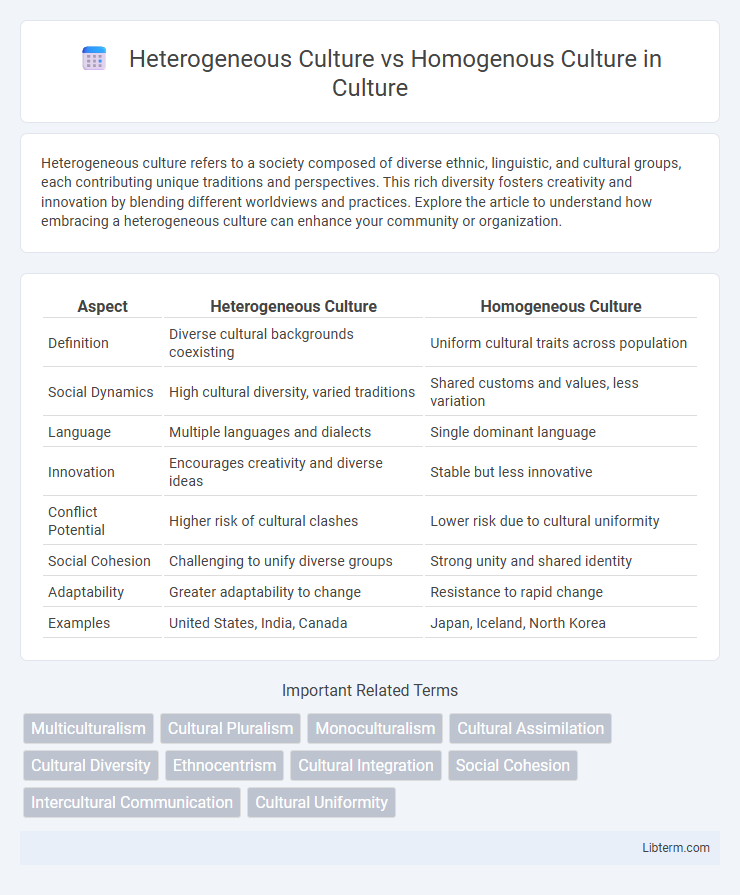Heterogeneous culture refers to a society composed of diverse ethnic, linguistic, and cultural groups, each contributing unique traditions and perspectives. This rich diversity fosters creativity and innovation by blending different worldviews and practices. Explore the article to understand how embracing a heterogeneous culture can enhance your community or organization.
Table of Comparison
| Aspect | Heterogeneous Culture | Homogeneous Culture |
|---|---|---|
| Definition | Diverse cultural backgrounds coexisting | Uniform cultural traits across population |
| Social Dynamics | High cultural diversity, varied traditions | Shared customs and values, less variation |
| Language | Multiple languages and dialects | Single dominant language |
| Innovation | Encourages creativity and diverse ideas | Stable but less innovative |
| Conflict Potential | Higher risk of cultural clashes | Lower risk due to cultural uniformity |
| Social Cohesion | Challenging to unify diverse groups | Strong unity and shared identity |
| Adaptability | Greater adaptability to change | Resistance to rapid change |
| Examples | United States, India, Canada | Japan, Iceland, North Korea |
Introduction to Culture: Definitions and Context
Heterogeneous culture encompasses diverse customs, languages, and beliefs within a community, fostering innovation and multicultural understanding. Homogeneous culture features uniform traditions and shared values that promote social cohesion and collective identity. Understanding these cultural frameworks provides insight into societal dynamics and influences communication, behavior, and social integration.
What is a Homogeneous Culture?
A homogeneous culture is characterized by shared values, beliefs, language, and customs within a group, resulting in cultural uniformity and social cohesion. This cultural consistency fosters strong group identity and predictable social norms, often found in societies with limited ethnic or linguistic diversity. Homogeneous cultures contrast with heterogeneous cultures, where diverse cultural elements coexist, leading to varied social practices and increased intercultural interactions.
What is a Heterogeneous Culture?
A heterogeneous culture consists of diverse ethnic, linguistic, and social groups coexisting within the same society, fostering a rich tapestry of customs, beliefs, and traditions. This cultural diversity encourages innovation, broadens perspectives, and enhances social adaptability by integrating multiple cultural identities. Examples include countries like the United States and India, where multiculturalism shapes social dynamics and economic collaboration.
Key Differences Between Homogeneous and Heterogeneous Cultures
Homogeneous cultures consist of individuals who share similar ethnic backgrounds, language, and traditions, resulting in uniform social norms and values. In contrast, heterogeneous cultures encompass diverse ethnicities, languages, and customs, fostering multicultural integration and adaptability. This diversity in heterogeneous cultures often leads to greater innovation and broader perspectives, while homogeneous cultures may emphasize social cohesion and stability.
Social Cohesion in Homogeneous Cultures
Homogeneous cultures often exhibit higher levels of social cohesion due to shared values, traditions, and common language, which foster strong interpersonal bonds and collective identity. Social cohesion in these cultures enhances cooperation, trust, and social stability, facilitating smooth community interactions and unified social norms. The uniform cultural background minimizes conflicts and misunderstandings, reinforcing social harmony and collective well-being.
Diversity and Multiculturalism in Heterogeneous Cultures
Heterogeneous cultures thrive on diversity, blending multiple ethnicities, languages, and traditions that foster innovation and broader perspectives in social and professional environments. Multiculturalism within these cultures promotes inclusivity and cross-cultural understanding, enhancing social cohesion despite differences. Homogenous cultures, by contrast, often exhibit uniformity in customs and beliefs, limiting exposure to diverse worldviews and reducing the dynamic intercultural exchange found in heterogeneous settings.
Impact on Communication and Language
Heterogeneous cultures foster diverse communication styles and multilingualism, enhancing cross-cultural understanding but sometimes leading to misunderstandings due to varying linguistic norms and nonverbal cues. Homogenous cultures typically exhibit uniform language use and shared communicative practices, which streamline interactions and reduce misinterpretation risks within the group. The presence of multiple cultural perspectives in heterogeneous environments demands advanced communication skills, while homogenous settings emphasize consistency and clarity in language use.
Effects on Innovation and Creativity
Heterogeneous cultures, characterized by diverse backgrounds and perspectives, significantly enhance innovation and creativity by fostering a wide range of ideas and problem-solving approaches. Homogenous cultures tend to have uniform viewpoints, which can limit creative thinking and reduce the potential for breakthrough innovations. Diverse teams in heterogeneous cultures are more likely to generate novel solutions and adapt quickly to changing environments, driving competitive advantages.
Challenges and Opportunities in Each Culture Type
Heterogeneous cultures present challenges such as communication barriers, conflicts arising from diverse values, and difficulties in achieving consensus, yet they offer opportunities for creativity, innovation, and diverse problem-solving approaches. Homogenous cultures face challenges including resistance to change and limited perspectives but benefit from social cohesion, easy communication, and unified cultural identity. Navigating these dynamics requires tailored leadership strategies that leverage diversity's strengths or reinforce cohesion depending on the cultural context.
Conclusion: Embracing Cultural Differences
Embracing cultural differences fosters innovation, creativity, and adaptability in both heterogeneous and homogeneous cultures. Organizations and societies benefit from diverse perspectives that drive problem-solving and enhance global competitiveness. Prioritizing inclusivity and mutual respect strengthens social cohesion and promotes sustainable growth in an interconnected world.
Heterogeneous Culture Infographic

 libterm.com
libterm.com